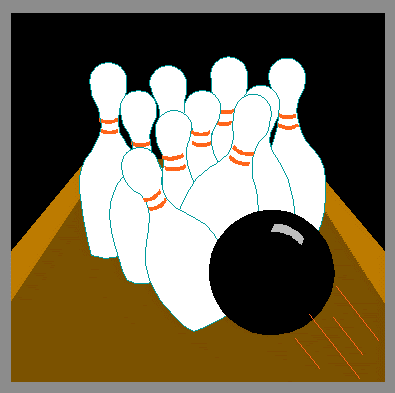“Moveon.org endorsed [Sen. Barack Obama] -- which is like a gusher of money that never seems to slow down," Clinton said to a meeting of donors. "We have been less successful in caucuses because it brings out the activist base of the Democratic Party. MoveOn didn't even want us to go into Afghanistan. I mean, that's what we're dealing with. And you know they turn out in great numbers. And they are very driven by their view of our positions, and it's primarily national security and foreign policy that drives them. I don't agree with them. They know I don't agree with them. So they flood into these caucuses and dominate them and really intimidate people who actually show up to support me."You can read their entire post by clicking here where audio of Senator Clinton’s remarks is also provided. I’m hardly the first blogger to post about this and surely won’t be the last. Many across the progressive blogosphere venting about Clinton’s rhetorical cluster bomb against the Democratic Party’s activist base are far more articulate than me. Nevertheless, I feel compelled to hit back on behalf of this movement I proudly call my own. I first became aware of Moveon.org when they stood up for the Constitution and supported censure over impeachment during the Monica Lewinsky scandal a decade ago. I was delighted such a movement sprang from the toxic bile of Ken Starr’s witch-hunt. Do you remember Senator Clinton how we advocated for censure as a means of “moving on”? We were your allies against the racist and misogynist “right wing conspiracy” represented by Richard Mellon Scaife that you now sit down with to exploit racial divisions. So to paraphrase James Carville, attacking us is “an act of betrayal” that resembles Judas. Anyway, that was the beginning of the netroots movement. After 9/11 Moveon.org was an oasis in a dessert of reactionary enablers that included Hillary Clinton in the lead up to the Iraq War. Sadly, Clinton even echoed the administration’s lies about connections between Saddam Hussein and al quaeda! Not only did Clinton fail to read contrary arguments about weapons of mass destruction in the mere ninety page National Intelligence Estimate, she also on the Senate floor said this on October 10, 2002: “He has also given aid, comfort, and sanctuary to terrorists, including Al Qaeda members, though there is apparently no evidence of his involvement in the terrible events of September 11, 2001.”Well, nice that Clinton said “apparently no evidence’ about Saddman and 9/11 but she implied there might be and the rest of the statement was an outright lie. Yet the only contrition Clinton expressed for years was “if I only knew then what I know now” while her Senate colleagues from 2002 Joe Biden, Chris Dodd, John Edwards and John Kerry eventually redeemed themselves for their transgressions by honestly acknowledging their mistakes. Clinton couldn’t even do that until recently and yes that angered Moveon.org members like me. Furthermore, Clinton lied about Moveon’s “opposition” to Afghanistan. Indeed she was echoing Karl Rove propaganda about the Democrats and Afghanistan. There was no organized opposition to America’s response in Afghanistan by Moveon.org. Speaking for myself, I knew there had to be a military response to 9/11 but for damn sure I didn’t trust the Bush Administration to do it skillfully and retain the international community’s good will. And yes I worried about the loss of innocent life, largely women and children, who would lose their lives while nothing was accomplished. Sadly, that is what has come to pass. Moveon.org members are my brothers and sisters. Fellow patriots and activists mobilized to reverse America’s homicidal/suicidal foreign policy and grotesque erosion of civil liberties. They represent the core of the people powered social networking netroots movement determined to make America the best America it can be. It’s rather like a large extended virtual family that has moved beyond Moveon.org and is really a decentralized community. We coordinate to raise money, phone bank and canvass on behalf of causes larger than ourselves. Like all families, individual members of Moveon.org and the netroots as a whole don’t always agree about tactics or which candidates to support. For example, I didn’t think the “Betraus” ad last fall was very smart. Previously, I had intense email debates with other bloggers about my support for John Edwards. I had posted a heartfelt endorsement of Edwards and some Obama supporters I enjoyed email correspondences with over the years hit me hard. On the bigger picture though we’re on the same side even as squabbles happen over how to best achieve the objectives we share. Once Edwards dropped out I put my disappointment aside because I sensed Obama’s candidacy better represented the sensibilities of this movement I’m a part of than Clinton. I also hunger for our netroots movement to achieve critical mass beyond white liberal computer literate activists to better combine with organized labor and more effectively fight on behalf of wage earners. We're making substantial progress in that direction as the movement has grown so fast. And yet not fast enough. Hence, it’s easy to become frustrated. But Moveon’s movement is my movement and I’m in it for the long haul no matter what happens in 2008. The netroots people powered movement is fighting to take the Democratic Party from predatory moneylenders, warmongers and corporatists and push our country towards progressive reform. A tough ongoing struggle waged against powerful interests. These interests include the incestuous relationship between the corporate media and the military industrial complex as exists between NBC and General Electric. And if you think the recent performance of moderators Charles Gibson and George Stephanopolous during the Clinton/Obama debate and the perverse reactionary values of ABC’s parent company Walt Disney are a coincidence, I have bridge in my hometown of Brooklyn I’d like to sell you. Senator Clinton’s whining about activists like myself who are informed, passionate and motivated to fight the madness that war mongering enablers like her supported is quite revealing. Her whining about funds raised online “like a gusher of money that never seems to slow down," is even more revealing. Clinton receives contributions by the banks and credit card companies “like a gusher” and supported predatory bankruptcy legislation in 2001. Big money contributors that support Senator Clinton benefit from laws that destroy the lives of families on the financial abyss whenever a loved one suffers from an expensive medical calamity. Moveon.org’s money doesn’t come from insurance companies, HMOs, Halliburton, Bechtel, BlackWater USA, K-Street lobbyists, banks, credit card companies or other war mongering corporatist predators. Hence, this “gusher of money” is beyond the comprehension of Clinton and Washington insiders such as James Carville. This money comes from regular folks giving what they can even as we too struggle with our groceries bill, energy costs and mortgages. Yet they call us elitists? There is also the lie about our “intimidating” her supporters at caucuses. Listen up: I subscribe to something Howard Dean has said many times, that it would be far better for this country to have 100% voter turnout even if Republicans win. I’ve registered all kinds of people to vote who don’t share my beliefs and so have many dedicated activists who also belong to Moveon.org and make our voices heard in the progressive blogosphere. I don’t own a gun or attend religious services. Nor do I wear a flag pin. Neither does military veteran and Virginia Senator James Webb. I’m also not a good bowler. Admittedly, I am “bitter” about the direction of my country. But I’m as good an American as you are Senator Clinton. And yes I’m a member of Moveon.org and will give another $25 to Senator Obama today. Anyone care to join me and help raise money like a gusher? If so, click here. |
Saturday, April 19, 2008
I'm A Member of Moveon.org & A Terrible Bowler
Posted by
Robert Ellman
at
10:10 AM
0
comments
![]()
Labels: barack obama, hillary clinton, Huffington Post, Moveon.org
Friday, April 18, 2008
Black History: Trusting Whitey
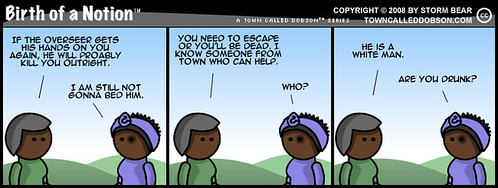 click to enlarge Even at the height of the Underground Railroad, fewer than two thousand slaves from all slaveholding states were able to escape each year, a quantity much smaller than the natural annual increase of the enslaved population. Though the economic impact was small, the psychological impact upon slaveholders of a well-organized network to assist escaped slaves was immense. Under the original Fugitive Slave Law of 1793, the responsibility for catching runaway slaves fell to officials of the states from whence the slaves came, and the Underground Railroad thrived. With heavy political lobbying, the Compromise of 1850, passed by Congress after the Mexican-American War, stipulated a more stringent Fugitive Slave Law. Ostensibly, the compromise redressed all regional complaints. However, it coerced officials of free states to assist slave catchers if there were runaway slaves in the area, and granted slave catchers national immunity when in free states to do their job. Additionally, freed blacks of the North could easily be forced into slavery, as all suspected slaves were not eligible for a trial and it was difficult to prove a free status. Thus, many Northerners who would have otherwise been able and content to ignore far-away regional slavery chafed under nationally-sanctioned slavery, leading to one of the primary grievances of the Union cause by the Civil War's outbreak. The escape network of The Underground Railroad was not literally subterranean, but rather "underground" in the sense of underground resistance. The network was known as a "railroad" by way of the use of rail terminology in the code. The Underground Railroad consisted of meeting points, secret routes, transportation, and safe houses, and assistance provided by abolitionist sympathizers. Individuals were often organized in small, independent groups, which helped to maintain secrecy since some knew of connecting "stations" along the route but few details of their immediate area. Escaped slaves would move along the route from one way station to the next, steadily making their way north. "Conductors" on the railroad came from various backgrounds and included free-born blacks, white abolitionists, former slaves (either escaped or manumitted), and Native Americans. Churches also often played a role, especially the Religious Society of Friends (Quakers), Congregationalists, Wesleyans, and Reformed Presbyterians as well as certain sects of mainstream denominations such as branches of the Methodist church and American Baptists. For more details check out National Geographic's site for the Underground Railroad Disclaimer:
BIRTH OF A NOTION WALLPAPER is now available for your computer. Click here. |
Posted by
Storm Bear
at
9:40 AM
0
comments
![]()
Labels: cartoons, comics, slave trade, slavery, underground railroad, webcomics
Thursday, April 17, 2008
Charlie Gibson's Debate: 4 Cartoons
 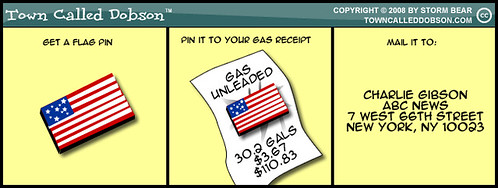 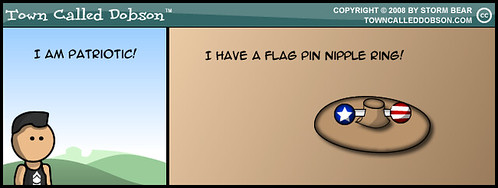  click to enlarge Anyway, I didn't know which strip to choose, so I am publishing them all. You get to decide which is best. |
Posted by
Storm Bear
at
6:12 AM
1 comments
![]()
Labels: barack obama, cartoons, charlie gibson, comics, debate, hillary clinton, humor, politics, webcomics
Wednesday, April 16, 2008
Black History: Overseers
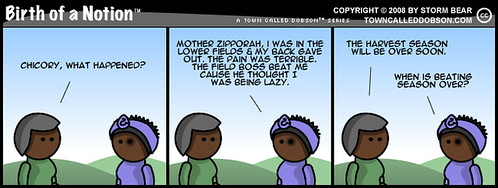 click to enlarge Although complete statistics are lacking, it is estimated that 1,000,000 slaves moved west between 1790 and 1860. Most of the slaves were moved from Maryland, Virginia, and the Carolinas. Originally the points of destination were Kentucky and Tennessee, but after 1810 Georgia, Alabama, Mississippi, Louisiana and Texas received the most. In the 1830s, almost 300,000 were transported, with Alabama and Mississippi receiving 100,000 each. Every decade between 1810 and 1860 saw at least 100,000 slaves moved from their state of origin. In the final decade before the Civil War, 250,000 were moved. Michael Tadman, in a 1989 book Speculators and Slaves: Masters, Traders, and Slaves in the Old South, indicates that 60-70% of interregional migrations were the result of the sale of slaves. In 1820 a child in the Upper South had a 30% chance to be sold South by 1860. Slave traders were responsible for the majority of the slaves that moved west. Only a minority moved with their families and existing owner. Slave traders had little interest in purchasing or transporting intact slave families, although in the interest of creating a "self-reproducing labor force" equal numbers of men and women were transported. Berlin wrote, "The internal slave trade became the largest enterprise in the South outside the plantation itself, and probably the most advanced in its employment of modern transportation, finance, and publicity." The slave trade industry developed its own unique language with terms such as "prime hands, bucks, breeding wenches, and fancy girls" coming into common use. The expansion of the interstate slave trade contributed to the "economic revival of once depressed seaboard states" as demand accelerated the value of the slaves that were subject to sale. Some traders moved their "chattels" by sea, with Norfolk to New Orleans being the most common route, but most slaves were forced to walk. Regular migration routes were established and were served by a network of slave pens, yards, and warehouses needed as temporary housing for the slaves. As the trek advanced, some slaves were sold and new ones purchased. Berlin concluded, "In all, the slave trade, with its hubs and regional centers, its spurs and circuits, reached into every cranny of southern society. Few southerners, black or white, were untouched." The death rate for the slaves on their way to their new destination across the American South was no where near that of the captives on their way across the Atlantic Ocean, but they were still higher than the normal death rate. Berlin summarizes the experience:
Once the trip was ended, slaves faced a life on the frontier significantly different from their experiences back east. Clearing trees and starting crops on virgin fields was harsh and backbreaking work. A combination of inadequate nutrition, bad water, and exhaustion from both the journey and the work weakened the newly arrived slaves and produced casualties. The preferred locations of the new plantations in river bottoms with mosquitoes and other environmental challenges threatened the survival of slaves, who had acquired only limited immunities in their previous homes. The death rate was such that, in the first few years of hewing a plantation out of the wilderness, some planters preferred whenever possible to use rented slaves rather than their own. The harsh conditions on the frontier increased slave resistance and led to much more reliance on violence by the owners and overseers. Many of the slaves were new to cotton fields and unaccustomed to the "sunrise-to-sunset gang labor" required by their new life. Slaves were driven much harder than when they were involved in growing tobacco or wheat back east. Slaves also had less time and opportunity to boost the quality of their lifestyle by raising their own livestock or tending vegetable gardens, for either their own consumption or trade, as they could in the eastern south. In Louisiana it was sugar, rather than cotton, that was the main crop. Between 1810 and 1830 the number of slaves increased from under 10,000 to over 42,000. New Orleans became nationally important as a slave port, and by the 1840s had the largest slave market in the country. Dealing with sugar cane was even more physically demanding than growing cotton, and the preference was for young males who represented two-thirds of the slave purchases. The largely young, unmarried male slave force made the reliance on violence by the owners “especially savage.” Historian Kenneth M. Stampp describes the role of coercion in slavery, “Without the power to punish, which the state conferred upon the master, bondage could not have existed. By comparison, all other techniques of control were of secondary importance.” Stampp further notes that while rewards sometimes led slaves to perform adequately, most agreed with an Arkansas slaveholder, who wrote:
According to both the Pulitzer Prize-winning historian David Brion Davis and the Marxist historian Eugene Genovese, treatment of slaves was both harsh and inhumane. Whether laboring or walking about in public, people living as slaves were regulated by legally authorized violence. Davis makes the point that, while some aspects of slavery took on a "welfare capitalist" look,:
On large plantations, slave overseers were authorized to whip and brutalize non-compliant slaves. Slave codes authorized, indemnified or even required the use of violence, and were denounced by abolitionists for their brutality. Both slaves and free blacks were regulated by the Black Codes, and had their movements monitored by slave patrols conscripted from the white population which were allowed to use summary punishment against escapees, sometimes maiming or killing them. In addition to physical abuse and murder, slaves were at constant risk of losing members of their families if their owners decided to trade them for profit, punishment, or to pay debts. A few slaves retaliated by murdering owners and overseers, burning barns, killing horses, or staging work slowdowns. Stampp, without contesting Genovese's assertions concerning the violence and sexual exploitation faced by slaves, does question the appropriateness of a Marxian approach in analyzing the owner-slave relationship. Genovese claims that because the slaves were the legal property of their owners, it was not unusual for enslaved black women to be raped by their owners, members of their owner's families, or their owner's friends. Children who resulted from such rapes were slaves as well, as they took the status of their mothers, unless freed by the slaveholder. Nell Irwin Painter and other historians have also documented that Southern history went "across the color line". Contemporary accounts by Mary Chesnut and Fanny Kemble, both married in the planter class, as well as accounts by former slaves gathered under the Works Progress Administration (WPA), all attested to the abuse of women slaves by white men of the owning and overseer class. However, the Nobel economist Robert Fogel controversially describes the belief that slave-breeding and sexual exploitation destroyed the black family as a myth. The family was the basic unit of social organization under slavery; it was to the economic interest of planters to encourage the stability of slave families, and most of them did so. Most slave sales were either of whole families or of individuals who were at an age when it would have been normal for them to have left the family. According to Genovese, slaves were fed, clothed, housed and provided medical care in the most minimal manner. It was common to pay small bonuses during the Christmas season, and some slave owners permitted their slaves to keep earnings and gambling profits. (One slave, Denmark Vesey, is known to have won a lottery and bought his freedom.) In many households, treatment of slaves varied with the slave's skin color. Darker-skinned slaves worked in the fields, while lighter-skinned house servants had comparatively better clothing, food and housing. As in President Thomas Jefferson's household, this was not merely an issue of skin color. Sometimes planters used light-skinned slaves as house servants because they were relatives. Several of Jefferson's household slaves were children of his father-in-law and an enslaved woman, who were brought to the marriage by Jefferson's wife. However, Fogel argues that the material conditions of the lives of slaves compared favorably with those of free industrial workers. They were not good by modern standards, but this fact emphasizes the hard lot of all workers, free or slave, during the first half of the 19th century. Over the course of his lifetime, the typical slave field hand received about 90 percent of the income he produced. In a survey, 58 percent of historians and 42 percent of economists disagreed with the proposition that the material condition of slaves compared favorably with those of free industrial workers. Slaves were considered legal non-persons except if they committed crimes. An Alabama court asserted that slaves "are rational beings, they are capable of committing crimes; and in reference to acts which are crimes, are regarded as persons. Because they are slaves, they are incapable of performing civil acts, and, in reference to all such, they are things, not persons." In 1811, the Arthur William Hodge was the first slave owner executed for the murder of a slave in the British West Indies. He though was not, as some have claimed, the first white person to have been lawfully executed for the killing of a slave. Records indicate at least two earlier incidents. On November 23, 1739, in Williamsburg, Virginia, two white men, Charles Quin and David White, were hanged for the murder of another white man's black slave; and on April 21, 1775, the Fredericksburg newspaper, the Virginia Gazette reported that a white man William Pitman had been hanged for the murder of his own black slave. While working on plantations and farms, women and men had equal labor-intensive work. However, much of the hard labor was taken care of by men or by women who were past the child-bearing stage. Some of the labor-intensive jobs given to women were: cooking for the owner's household as well as the slaves themselves, sewing, midwifery, pruning fields, and many other labor-intensive occupations. In 1837, an Antislavery Convention of American Women met in New York City with both black and white women participating. Lucretia Mott and Elizabeth Cady Stanton had first met at the convention and realized the need for a separate women's rights movement. At the London gathering Stanton also met other women delegates such as Emily Winslow, Abby Southwick, Elizabeth Neal, Mary Grew, Abby Kimber, as well as many other women. However, during the Massachusetts Anti-slavery Society meetings, which Stanton and Winslow attended, the hosts refused to seat the women delegates. This resulted in a convention of their own to form a "society to advocate the rights of women" (Sklar). In 1848 at Seneca Falls, New York, Stanton and Winslow launched the women's rights movement, becoming one of the most diverse and social forces in American life. Disclaimer:
BIRTH OF A NOTION WALLPAPER is now available for your computer. Click here. |
Posted by
Storm Bear
at
6:07 AM
0
comments
![]()
Labels: Africa, cartoons, comics, overseers, second middle passage, slavery, webcomics
Tuesday, April 15, 2008
How much taxation is too much?
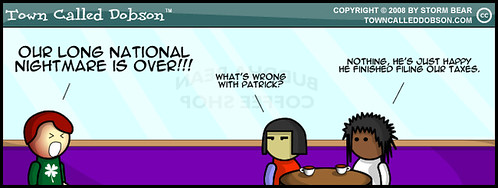 click to enlarge Both arguments are idiotic because it cost money to run a nation. It takes a whole bunch of money to run a superpower. I have started asking GOPers if they are willing to dump America's superpower status for lower taxes? Are they willing to dump 95% of military spending? Are they willing to dump publicly funded schools and colleges, Social Security, Medicare and Medicaid? How about halting all new road and rail construction? Nope. They have a fantasy about how you can cut taxes to nothing and somehow your bills get paid. There are other obstacles to lower taxes and that is the military industrial complex. They have their hand so far up Government's ass that our elected officials can't seem to lower our defense spending. But with all problems, there are solutions. The first being taking civil rights away from companies and outright banning lobbyists. If the courage for that is missing, work with MIC and change military spending to something that pushes humanity forward, spurs job growth and keeps the military industrial complex happy with contracts. One idea is to swap our defense spending with things like green energy development, space exploration, etc. These large scale projects require large sums of cash, but help people in other ways - ways that invading Iraq does not. It is not a total solution to our governmental spending problems and taxation, but it is one small part. Frankly, I would rather go to Mars than Iran - and Mars would be a whole lot cheaper. Subscribe to Town Called Dobson by Email! |
Posted by
Storm Bear
at
5:53 AM
0
comments
![]()
Labels: april 15th, cartoons, comics, humor, irs, politics, taxes, webcomics
Monday, April 14, 2008
Black History: The Native Americans
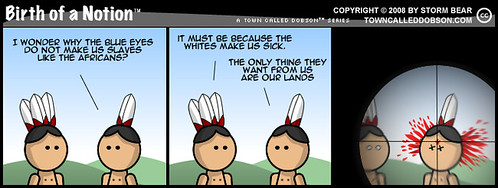 click to enlarge The first Native American group encountered by Christopher Columbus were the Island Arawaks (more properly called the Taino) of Boriquen (Puerto Rico), the (Quisqueya) of the Dominican Republic, and the Cubanacan (of Cuba). It has been said that of the 250,000 to one million Island Arawaks living in 1492, only about 500 had survived by the middle of the 16th century, and that the group was considered extinct by the middle of the 17th century. However, DNA studies show that the genetic contribution of the Taino to that region continues, and the mitochondrial DNA studies of the Taino are said to show relationships to the Northern Indigenous Nations, such as Inuit and others. European settlers brought infectious diseases against which the Native Americans had no natural immunity. Chicken pox and measles, though common and rarely fatal among Europeans, often proved deadly to Native Americans. Smallpox proved particularly deadly to Native American populations. Epidemics often immediately followed European exploration, sometimes destroying entire villages. While precise figures are difficult to arrive at, some historians estimate that up to 80% of some Native populations died due to European diseases. In 1617–1619, smallpox wiped out 90% of the Massachusetts Bay Native Americans. As it had done elsewhere, the virus wiped out entire population groups of Native Americans. It reached Mohawks in 1634, Lake Ontario in 1636, and the lands of the Iroquois by 1679. During the 1770s, smallpox killed at least 30% of the West Coast Native Americans. Smallpox epidemics in 1780–1782 and 1837–1838 brought devastation and drastic depopulation among the Plains Indians. By 1832, the federal government established a smallpox vaccination program for Native Americans (The Indian Vaccination Act of 1832). In the sixteenth century Spaniards and other Europeans brought horses to the Americas. Some of these animals escaped and began to breed and increase their numbers in the wild. Horses had previously migrated naturally to North America but the early American horse became game for the earliest humans and became extinct about 7,000 BC, just after the end of the last ice age. The re-introduction of the horse had a profound impact on Native American culture in the Great Plains of North America. As a new mode of travel the horse made it possible for some tribes to greatly expand their territories, exchange goods with neighboring tribes, and more easily capture game. During the 17th century, Indian slavery, the enslavement of Native Americans by European colonists, was common. Many of these Native slaves were exported to off-shore colonies, especially the "sugar islands" of the Caribbean. Historian Alan Gallay estimates that from 1670-1715, British slave traders sold between 24,000 and 51,000 Native Americans from what is now the southern part of the U.S. Slavery of Native Americans was organized in colonial and Mexican California through Franciscan missions, theoretically entitled to ten years of Native labor, but in practice maintaining them in perpetual servitude, until their charge was revoked in the mid-1830s. Following the 1847-1848 invasion by U.S. troops, Native Californians were enslaved in the new state from statehood in 1850 to 1867. Slavery required the posting of a bond by the slave holder and enslavement occurred through raids and a four-month servitude imposed as a punishment for Indian "vagrancy". The Haida and Tlingit Indians who lived along the Southeast Alaska's coast were traditionally known as fierce warriors and slave-traders, raiding as far as California. Slavery was hereditary, the slaves being prisoners of war. Among some Pacific Northwest tribes, about a quarter of the population were slaves. Other slave-owning tribes of North America were, for example, Comanche of Texas, Creek of Georgia, the fishing societies, such as the Yurok, that lived along the coast from what is now Alaska to California, the Pawnee, and Klamath. After 1800, the Cherokees and some other tribes started buying and using black slaves, a practice they continued after being relocated to Indian Territory in the 1830s. The nature of slavery in Cherokee society often mirrored that of white slave-owning society. The law barred intermarriage of Cherokees and blacks, whether slave or free. Blacks who aided slaves were punished with one hundred lashes on the back. In Cherokee society, blacks were barred from holding office, bearing arms, and owning property, and it was illegal to teach blacks to read and write. By contrast, the Seminoles welcomed into their nation African Americans who had escaped slavery (Black Seminoles). There were historical treaties between the European Colonists and the Native American tribes requesting the return of any runaway slaves. For example, in 1726, the British Governor of New York exacted a promise from the Iroquois to return all runaway slaves who had joined up with them. This same promise was extracted from the Huron Natives in 1764 and from the Delaware Natives in 1765. There are also numerous accounts of advertisements requesting the return of African Americans who had married Native Americans or who spoke a Native American language. Individuals in some tribes owned African slaves; however, other tribes incorporated African Americans, slave or freemen, into the tribe. This custom among the Seminoles was part of the reason for the Seminole Wars where the European Americans feared their slaves fleeing to the Natives. The Cherokee Freedmen and tribes such as the Lumbee in North Carolina include African American ancestors. After 1800, the Cherokees and some other tribes started buying and using black slaves, a practice they continued after being relocated to Indian Territory in the 1830s. The nature of slavery in Cherokee society often mirrored that of white slave-owning society. The law barred intermarriage of Cherokees and blacks, whether slave or free. Blacks who aided slaves were punished with one hundred lashes on the back. In Cherokee society, blacks were barred from holding office, bearing arms, and owning property, and it was illegal to teach blacks to read and write. Disclaimer:
BIRTH OF A NOTION WALLPAPER is now available for your computer. Click here. |
Posted by
Storm Bear
at
9:10 AM
0
comments
![]()
Labels: cartoons, comics, native americans, slavery, small pox, webcomics








